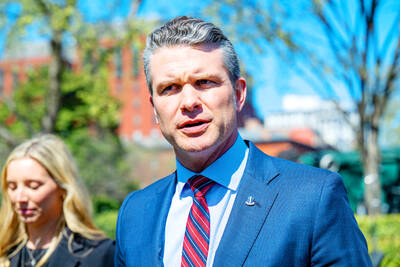The Ankeng light rail system is to commence operations at the end of the year as planned, the New Taipei City Government said on Wednesday, adding that more than 90 percent of the system has been completed.
New Taipei City Mayor Hou You-yi (侯友宜) in February inspected the first section of the light rail system, comprising stations K1 to K5.
On Wednesday, Hou, along with New Taipei City Department of Rapid Transport Systems Director Lee Cheng-an (李政安) and members of the media, took a test ride of the elevated second section of the system, which runs from stations K6 to K9.
Despite soaring commodity prices and a shortage of construction materials, more than 90 percent of the light rail system has been completed, Hou told reporters.
“The ride was smooth and the noise was within acceptable levels,” Hou said.
The light rail system would cut travel time for commuters from Ankeng to downtown Taipei or New Taipei City by 15 to 20 minutes, he said.
The system should also bolster local tourism as the route passes tourism hotspots such as the Erbazi Botanical Garden and the Sunshine Sports Park, he said.
As of April, all 15 light rail cars had been delivered and the entire line has since July 29 been undergoing core electromechanical system tests, the department said.
The installation of the power grid for the light rail system, its communication system, signals and monitoring systems are 85 percent complete, it added.
Although sound barriers have not yet been installed, the sound emitted by the light rail system is below the legal maximum of about 70 decibels, Lee said.
The light rail system spans 7.5km and passengers can connect to the Greater Taipei area via the circle line, the department said.

‘DENIAL DEFENSE’: The US would increase its military presence with uncrewed ships, and submarines, while boosting defense in the Indo-Pacific, a Pete Hegseth memo said The US is reorienting its military strategy to focus primarily on deterring a potential Chinese invasion of Taiwan, a memo signed by US Secretary of Defense Pete Hegseth showed. The memo also called on Taiwan to increase its defense spending. The document, known as the “Interim National Defense Strategic Guidance,” was distributed this month and detailed the national defense plans of US President Donald Trump’s administration, an article in the Washington Post said on Saturday. It outlines how the US can prepare for a potential war with China and defend itself from threats in the “near abroad,” including Greenland and the Panama

The Chinese Nationalist Party (KMT) is maintaining close ties with Beijing, the Democratic Progressive Party (DPP) said yesterday, hours after a new round of Chinese military drills in the Taiwan Strait began. Political parties in a democracy have a responsibility to be loyal to the nation and defend its sovereignty, DPP spokesman Justin Wu (吳崢) told a news conference in Taipei. His comments came hours after Beijing announced via Chinese state media that the Chinese People’s Liberation Army’s Eastern Theater Command was holding large-scale drills simulating a multi-pronged attack on Taiwan. Contrary to the KMT’s claims that it is staunchly anti-communist, KMT Deputy

RESPONSE: The government would investigate incidents of Taiwanese entertainers in China promoting CCP propaganda online in contravention of the law, the source said Taiwanese entertainers living in China who are found to have contravened cross-strait regulations or collaborated with the Chinese Communist Party (CCP) could be subject to fines, a source said on Sunday. Several Taiwanese entertainers have posted on the social media platform Sina Weibo saying that Taiwan “must be returned” to China, and sharing news articles from Chinese state media. In response, the Mainland Affairs Council (MAC) has asked the Ministry of Culture to investigate whether the entertainers had contravened any laws, and asked for them to be questioned upon their return to Taiwan, an official familiar with the matter said. To curb repeated

Myanmar has turned down an offer of assistance from Taiwanese search-and-rescue teams after a magnitude 7.7 earthquake struck the nation on Friday last week, saying other international aid is sufficient, the National Fire Agency said yesterday. More than 1,700 have been killed and 3,400 injured in the quake that struck near the central Myanmar city of Mandalay early on Friday afternoon, followed minutes later by a magnitude 6.7 aftershock. Worldwide, 13 international search-and-rescue teams have been deployed, with another 13 teams mobilizing, the agency said. Taiwan’s search-and-rescue teams were on standby, but have since been told to stand down, as